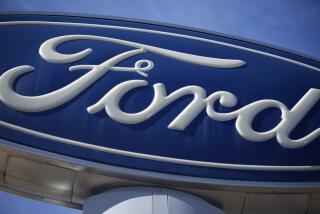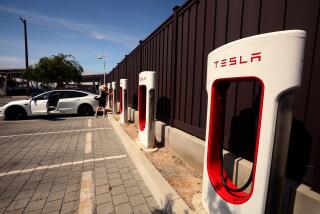Electric-Hybrid System to Be Tested in Pickups
NEW YORK â General Motors Corp. said Tuesday that it will begin testing a small fleet of electric-hybrid full-size pickup trucks in California and New York next year.
GM, which pioneered the introduction of electric vehicles in California, will become the first auto maker to demonstrate hybrid technology in light trucks.
The hybrid project underlines that the industry recognizes the limitations of battery-powered electric vehicles and is pushing into more advanced technologies in the race to replace the internal-combustion engine.
âHybrid-electric vehicles represent a potential near-term solution for improving fuel economy and, in most cases, improving emissions,â GM President G. Richard Wagoner said at the New York International Auto Show.
GM, the worldâs largest auto maker, plans to test 10 Chevrolet Silverado and GMC Sierra pickups that feature both a conventional gasoline internal-combustion engine and an electric motor powered by an advanced lead-acid battery.
All of the worldâs major auto makers are working on advanced vehicle technologies, including battery-powered electrics, hybrids and fuel-cell vehicles. As gas-gulping light trucks--minivans, sport-utility vehicles and pickups--gain in popularity, the companies are facing greater regulatory pressure to reduce tailpipe emissions and improve fuel economy.
Ten percent of vehicles sold in California beginning in 2003 must be zero-emission. Although hybrids do produce some emissions, they qualify for some zero-emission credits. In addition, California will begin phasing in rules in 2004 that require light trucks to meet the same emissions standards as cars.
Just a few years ago, battery-powered electrics were seen as a potential alternative to gas-powered cars and trucks. But the cost and range limitations of electric vehicles have dimmed their prospects for widespread use. GM has leased only about 600 of its two-seat EV1 electric cars in a little more than two years.
Now the industry is turning attention and resources to hybrids, which are regarded as the best near-term alternative to traditional engines. Hybrids are costlier and more complex than todayâs vehicles but offer similar range, better fuel economy and lower emissions.
Fuel cells, which use hydrogen and oxygen to create electricity to power a vehicle, are considered a longer-term bet if cost and other hurdles can be overcome.
Toyota Motor Corp. already sells a small hybrid sedan, the Prius, in Japan; it plans to introduce the car in the U.S. next year. Honda Motor Co. will beat Toyota to the U.S. market later this year with its VV hybrid, which gets 70 miles per gallon.
GMâs test vehicles will use a âpower-assistâ technology similar to that used by the Toyota and Honda hybrids. The VV, for example, relies on the combustion engine for normal driving and taps the electric motor only when extra power is needed, as at start-up or for passing.
GM will not sell the hybrid pickups but will put them in its own fleets to gather data about the vehiclesâ performance. It compares the approach to the extensive preview drive program it conducted before bringing the EV1 to market.
Although GM is the first auto maker to commit to a hybrid demonstration program with a light truck, Ford Motor Co. and DaimlerChrysler have shown concept trucks with either hybrid powertrains or fuel-cell systems.
âWe want to understand the suitability of hybrids for larger vehicles,â said Robert Purcell, GMâs chief of advanced vehicle technologies. âWe believe there may be a fundamental advantage to hybrids in larger classes of vehicles.â
In a speech to several hundred journalists Tuesday, Wagoner said the recent consolidation of the industry has in part been prompted by the need to share technology costs as the demand for clean engine systems increases. For instance, GM increased its stake in Isuzu Motors largely to obtain the Japanese companyâs truck and diesel engine technology.
GM announced in January 1998 that it would put an electric-hybrid vehicle in production by 2001. That is three years behind Toyota, but GM officials scoffed at suggestions that they are falling behind in the race to bring advanced-technology vehicles to market. They note that the company was the first to market an electric vehicle, has helped develop advanced batteries and is working on various hybrid vehicles as well as fuel cells.
âWe want to make a business out of this,â said Dennis Minano, GMâs chief environmental officer.
In other auto show news, GM unveiled its remodeled full-size sport-utility vehicles: the 2000 Chevy Suburban and 2000 GMC Yukon. The vehicles are evolutions of the current models, offering more interior space and enhanced handling, power, fuel economy and safety features.
Ford, meanwhile, unveiled its 2000 Taurus, the flagship mid-size sedan that has been a disappointment since it was given a radical ovoid design in 1995. The 2000 model has been given a more understated, conservative look likely to be more appealing to family-oriented buyers.
While downplaying design, Ford is emphasizing the Taurusâ safety features. It is the first Ford vehicle to feature a new âsmartâ air bag system that engages in a variety of ways depending on crash circumstances. The vehicle also features head and chest side air bags and a trunk-release latch to prevent accidental entrapment.






